Gumbo Photo Gallery
Gumbo is a Cajun/Creole soup which has been designated as the official state cuisine of Louisiana. There are many variants of gumbo. I take the variation to the extreme by incorporating lots of seasonal vegetables into my gumbos. The base of aromatics, smoked andouille sausage, a rich stock, and a dark roux provides a robust foundation that can accommodate many different seasonal options. My gumbos aren’t traditional, but they seem to be crowd pleasers.
The Elements
Smoked Andouille Sausage
My gumbo recipe is very flexible, but there are two required elements. The first is smoked andouille sausage. Andouille just says Louisiana Cajun to me. Not all andouille is made the same, so you should seek out a good one. It should be smokey, garlicy and peppery. Like bacon, a little can go a long way, and its nuances can permeate the entire dish.
Dry Roux
The second required ingredient is a dark roux. A roux is a thickening agent which is generally made by sautéing flour in a cooking fat. The roux in a gumbo is all about flavor. It’s a dark roux. You want the flour to brown as much as it can without burning. The traditional method for making a dark roux takes a long time, with nearly constant stirring. A kitchen hack for making a dark roux is to mix flour and vegetable oil and put it into a 350 degree oven. Over the course of 90 minutes to 2 hours, just stirring every 20-30 minutes, produces a nice, stress free dark roux. Another hack, which is my preferred method, forgoes the oil. Flour in a 500 degree oven for 45 minutes to an hour, with occasional stirring, produces toasted flour that can be mixed with stock for a virtually fat free roux. This method is called a dry roux and it works wonderfully in a gumbo.
Aromatics
Traditionally, a gumbo starts with the Cajun holy trinity of aromatics: onions, celery, and green bell peppers. If you have them, I fully encourage you to use them. I don’t normally have celery or green peppers in the fridge, but I always have onions in the pantry. More often than not, I start with just an onion. Oh, definitely add plenty of garlic after the other aromatics soften.
Stock
You can make gumbo with a store-bought chicken stock. I often do. You should know, however, gumbo is a dish where a special stock can shine. A really special stock can make a really special gumbo. One year we had a smoked turkey for Thanksgiving. I made a stock with the carcass. The leftover smoked turkey gumbo that I made with that stock was amazing. Whenever I make a seafood gumbo, I use a homemade shrimp stock (shrimp heads are cheap, and the stock is easy). Whenever I get a whole duck, I make duck stock. Gumbo made with duck stock and duck confit is off the hook. So, it’s fine to make some gumbo with store bought, packaged stock. But, when you have a special homemade stock, consider making a special gumbo!
Rice
Gumbo is traditionally served with rice. I like a brown rice, for the whole grain nutrition and flavor. I always have organic short grain brown rice in my pantry. Nothing fancy, I get it from the bulk section of my local co-op.
The Stuff
I consider gumbo to be a mother dish because I can find some combination of stuff that works well in a gumbo any season of the year. It’s not as flexible as, say, risotto. But, any week, I can head to the farmers’ market and find some stuff that works great together in a gumbo. All sorts of greens work well in gumbo, as exemplified by Gumbo Z’herbs. For every type of green in your bowl of Gumbo Z’herbs, you’ll meet a new friend. But, you must have an odd number of greens, else it is bad luck. For other ideas, explore the gallery at the top of this post.
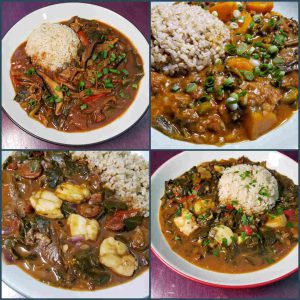
Gumbo – The Mother Dish Technique
Ingredients
- 1 cup all-purpose flour
- 1 Tbsp olive or vegetable oil
- 8 oz smoked andouille sausage removed from casing
- 1 medium yellow onion (6-8 oz) diced
- 5 garlic cloves (25 g) minced
- 1 tsp sweet paprika smoked is nice
- 1 tsp dried thyme
- 2 bay leaves
- ½ tsp red pepper flakes
- 8 cups good stock divided
- 8-12 oz additional proteins
- 1.5-2 lbs vegetables
- 1 tsp apple cider vinegar
- salt and pepper to taste
Instructions
For the Dry Roux:
- Note, for efficiency, start the dry roux first. You can compete the mise en place for the rest of the ingredients and start the gumbo recipe while the dry roux is baking. You can also bake the roux days ahead of time, storing in an airtight container, and mix in the stock when it is time to use the roux.
- Preheat the oven to 500 degrees. (Most dry roux recipes call for lower temperatures, but I find that the higher temperature cooks faster, with little risk of burning)
- Put the flour in an oven-safe pot. I used to use a skillet so the flour spread out further, but now I use a 3 quart sauce pan which allows me to aggressively stir the flour without spilling.
- Bake the flour, stirring occasionally, until it becomes uniformly the color of ground cinnamon. Expect at least 40 minutes, up to an hour. Be careful with the pan handle when you move the pan between the oven and stove top. It’s 500 degrees! As flour approaches desired state, you will notice an aroma reminiscent of burnt popcorn. Stir more frequently as the process continues. When you stir, break up the clumps of dry flour that form. Smooshing them with the back of a wooden spatula works well for me.
- Once the flour is baked, whisk in 2 cups of broth, a few ounces at a time. Be careful of the hot handle on the pan! The roux should come together as a thick, chocolate brown batter. Be sure to whisk entirely. You don’t want any lumps of flour stirred into your gumbo.
For the gumbo:
- Start by browning the sausage in the olive oil, separating it into small pieces as it cooks. Brown is flavor. The rendered fat from the sausage will permeate the entire dish!
- Next, add the onions (or the Creole holy trinity if you go that route) directly to the pot with the sausage and rendered fat. Add ½ tsp of salt to help draw the water out of the aromatics. You should find that there is enough oil and fat to make the aromatic mixture glisten. If it doesn’t glisten, add a bit more oil. Stir frequently, until the aromatic mixture has softened, 5 or 10 minutes.
- Stir the garlic, thyme, paprika, bay leaves, red pepper flakes and some freshly ground black pepper (about 1/4 teaspoon). Allow this mixture to cook for a minute or two.
- Add 6 cups of broth to the pot, along with the vegetables. Stir to incorporate. Simmer for 15 minutes. Taste for seasoning, adding a bit of salt if necessary.
- Slowly whisk the roux into the gumbo, a bit at a time. Make sure every bit gets fully incorporated. You can taste for seasoning at this point. The flavor of the roux at this point will not be pleasant. But over the next 30 minutes it will mellow and incorporate with all the other flavors in the gumbo.
- Simmer, the gumbo for another 30 minutes (longer simmering time is also fine). When you add the protein will vary. Proteins that will fair well with extended simmering (chicken or duck confit, for example) can be added as soon as the roux is mixed in. Proteins that cook fast and shouldn't be overcooked (shrimp or scallops, for example) should be added during the last 5 minutes of cooking.
- One final opportunity to taste for seasoning. At this point, I generally find that a bit of acid will brighten the gumbo. Stir in 1 tsp of apple cider vinegar and taste again. Adjust to taste.
- Plate with rice and garnish with something green – scallions, parsley, oregano are all nice options…

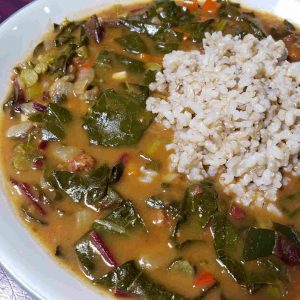
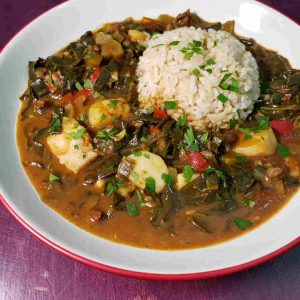
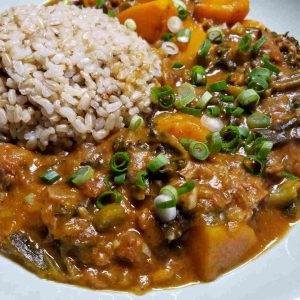
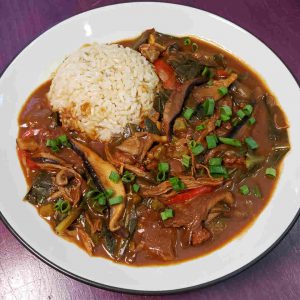
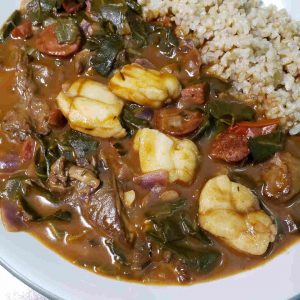
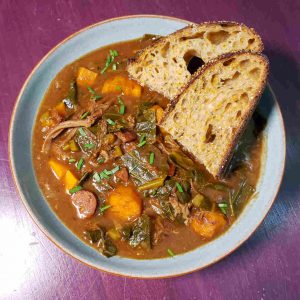
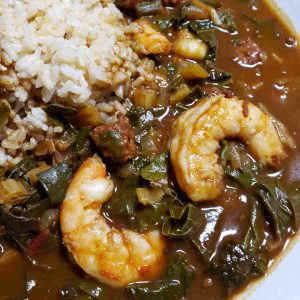






2 Responses
I’m making gumbo as I type. I always have celery, peppers and onions on hand. No problem there. Didn’t have any andouille sausage so used salami instead (salami is a sausage!). Also had leftover fried chicken and leftover smoked pork butt that I’d made. That all went into the pot. Earlier this week I’d made some fresh boiled crawfish. I browned the shells and claws that were left with some butter in the oven, added aromatics and chicken bones to make a very flavorful stock. That was my base. My mother always made a dry roux for stews so I’m familiar with that process. Normally add okra but I’ve found lima beans work great in gumbo. I use a bit more vinegar (white wine) than you do but vinegar definitely adds a brightness to the gumbo. My herbs are oregano, sage, rosemary, and fresh parsely, sometimes cumin. It tastes great every time and I never make it the same way twice. I’ll be adding some chopped shrimp at the end when serving with lots of hot rice. Geez, maybe I’ll make some cornbread, too. Thanks!
Hi Ann, Thanks for stopping by. You definitely know your way around a gumbo pot! That stock sounds off the hook! I love to include okra in the summer when it’s in season at my Carolina farmers’ markets. But as you note, lima beans go great in gumbo, and so do a lot of other vegetable combinations. Keep on cooking!